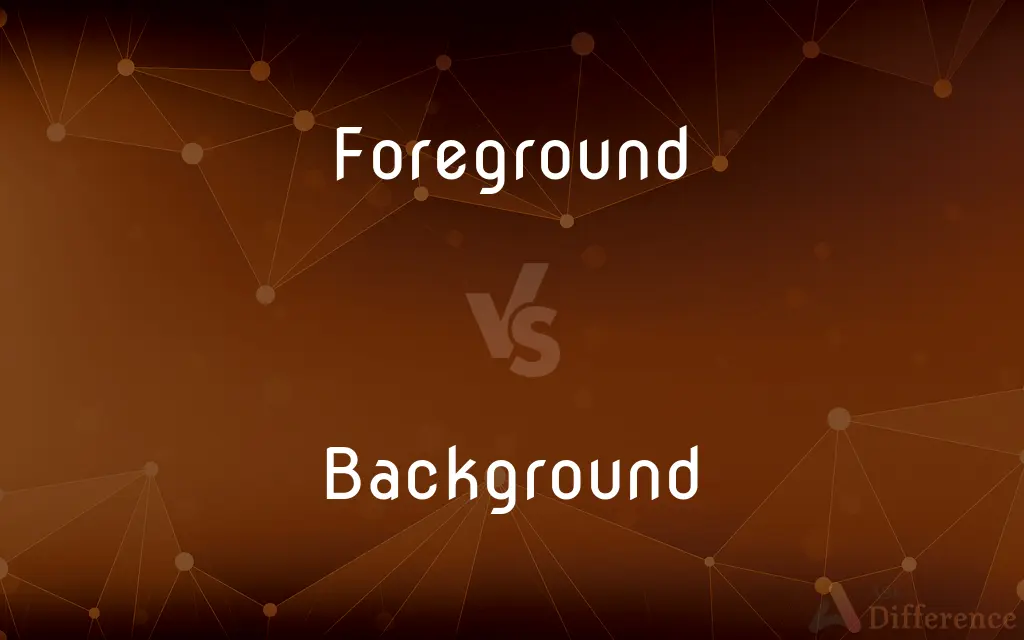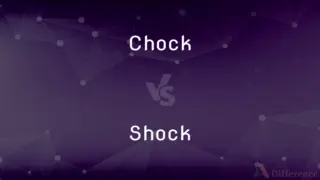Foreground vs. Background — What's the Difference?
By Tayyaba Rehman — Updated on October 25, 2023
The "foreground" is the part of a scene nearest to the viewer, while the "background" is the area that appears behind the main subject.

Difference Between Foreground and Background
Table of Contents
ADVERTISEMENT
Key Differences
In visual art and imagery, "foreground" and "background" are terms used to describe the placement and prominence of elements. The "foreground" typically contains objects or subjects placed closest to the viewer. These are elements that first catch the eye and usually hold significant importance in the scene. Conversely, the "background" constitutes the elements or scenes positioned behind the main subjects. They offer context but might not be the central focus.
When considering composition, the "foreground" often provides depth to an image. It can introduce a subject, create leading lines, or add layers to the scene, making the image three-dimensional and engaging. In contrast, the "background" sets the stage, offering contextual cues. Whether it's a serene sky, a bustling cityscape, or a quiet room, the background gives viewers a sense of setting.
In design and software applications, "foreground" and "background" can refer to different things. The "foreground" might refer to active windows or applications that users interact with directly, whereas the "background" might denote processes running unseen or the backdrop of a desktop. In this realm, the foreground takes precedence in user interaction, while the background often hums quietly, supporting the main operations.
To encapsulate, the "foreground" is about prominence, immediacy, and direct interaction, whether in art, photography, or software. The "background", while sometimes subtler, provides context, setting, and supports the primary subject or operation.
Comparison Chart
Position
Closest to the viewer.
Farther from the viewer, behind the subject.
ADVERTISEMENT
Role
Introduces main subjects or adds depth to a scene.
Provides context or setting.
Prominence
Typically more noticeable and immediate.
Often subtler, less immediately noticeable.
Interaction (in software)
Active windows or applications users engage with.
Processes running unseen or desktop backdrop.
Importance
Holds significant importance in composition.
Offers context but might not be the main focus.
Compare with Definitions
Foreground
Prominent objects or elements in a composition.
The artist painted a vivid animal in the foreground.
Background
The area of a scene positioned behind the main subjects.
The mountains in the background added beauty to the scene.
Foreground
The area of a scene closest to the viewer.
The flowers in the foreground added depth to the photograph.
Background
The setting or context in imagery.
The painting's background was a calm, serene ocean.
Foreground
Active applications or windows in software.
The software brought the application to the foreground.
Background
Less immediately noticeable elements in a composition.
The subtle hues in the background set the mood.
Foreground
Elements that first catch the viewer's attention.
The dramatic colors in the foreground grabbed my attention.
Background
The part of a picture, scene, or design that forms a setting for the main figures or objects, or appears furthest from the viewer
The word is written in white on a red background
The house stands against a background of sheltering trees
Foreground
The part that provides a sense of depth in imagery.
The rocks in the foreground contrasted the distant mountains.
Background
The circumstances or situation prevailing at a particular time or underlying a particular event
The political and economic background
Background information
Foreground
The part of a scene or picture that is nearest to and in front of the viewer.
Background
Form a background to
Windswept land backgrounded by the Rockies
Foreground
See forefront.
Background
Provide with background
The embassy backgrounded American reporters
Foreground
To place in the foreground; call attention to
"He is currently at work on a trilogy of pieces ... which foreground the Algerian War" (Eleanor Heartney).
Background
The ground or scenery located behind something.
Foreground
The elements of an image which lie closest to the picture plane.
Background
The part of a pictorial representation that appears to be in the distance and that provides relief for the principal objects in the foreground.
Foreground
The subject of an image, often depicted at the bottom in a two-dimensional work.
Background
The general scene or surface against which designs, patterns, or figures are represented or viewed.
Foreground
The application the user is currently interacting with; the application window that appears in front of all others.
Background
A position, area, or situation that is not immediately in one's attention or notice
You can hear traffic moving in the background during the interview.
Foreground
To place in the foreground (physically or metaphorically).
Background
(Computers) The environment in which programs operate that the user does not engage with directly
Processes that run in the background.
Foreground
The part of a scene that is near the viewer
Background
The circumstances and events surrounding or leading up to an event or occurrence.
Foreground
(computer science) a window for an active application
Background
A person's experience, training, and education
Her background in the arts is impressive.
Foreground
Move into the foreground to make more visible or prominent;
The introduction highlighted the speaker's distinguished career in linguistics
Background
The cultural or social environment in which a person was brought up or has lived
A class with students from many different backgrounds.
Background
Subdued music played especially as an accompaniment to dialogue in a dramatic performance.
Background
Sound that intrudes on or interferes with an audio recording.
Background
Low-level radiation, as from radioactive decay, that exists as part of the natural environment.
Background
Less important or less noticeable in a scene or system.
Background noise
The antivirus program runs on a background thread.
Background
One's social heritage, or previous life; what one did in the past.
The lawyer had a background in computer science.
Background
A part of the picture that depicts scenery to the rear or behind the main subject; context.
Background
Information relevant to the current situation about past events; history.
Background
A less important feature of scenery (as opposed to foreground).
There was tons of noise in the background.
The photographer let us pick a background for the portrait.
Background
(computing) The image or color over which a computer's desktop items are shown (e.g. icons or application windows).
Background
(computing) A type of activity on a computer that is not normally visible to the user.
The antivirus program is running in the background.
Background
(physics) background radiation
Background
To put in a position that is not prominent.
Background
(journalism) To gather and provide background information (on).
Background
Ground in the rear or behind, or in the distance, as opposed to the foreground, or the ground in front.
Background
The space which is behind and subordinate to a portrait or group of figures.
Background
Anything behind, serving as a foil; as, the statue had a background of red hangings.
Background
A place in obscurity or retirement, or out of sight.
I fancy there was a background of grinding and waiting before Miss Torry could produce this highly finished . . . performance.
A husband somewhere in the background.
Background
The set of conditions within which an action takes place, including the social and physical conditions as well as the psychological states of the participants; as, within the background of the massive budget deficits of the 1980's, new spending programs had little chance of passage by the congress.
Background
The set of conditions that precede and affect an action, such as the social and historical precedents for the event, as well as the general background{5}; as, against the background of their expulsion by the Serbs, the desire of Kosovars for vengeance is understandable though regrettable.
Background
The signals that may be detected by a measurement which are not due to the phenomenon being studied, and tend to make the measurement uncertain to a greater or lesser degree.
Background
An agreement between a journalist and an interviewee that the name of the interviewee will not be quoted in any publication, although the substance of the remarks may be reported; - often used in the phrase "on background". Compare deep background.
Background
A person's social heritage: previous experience or training;
He is a lawyer with a sports background
Background
The part of a scene (or picture) that lies behind objects in the foreground;
He posed her against a background of rolling hills
Background
Information that is essential to understanding a situation or problem;
The embassy filled him in on the background of the incident
Background
Extraneous signals that can be confused with the phenomenon to be observed or measured;
They got a bad connection and could hardly hear one another over the background signals
Background
Relatively unimportant or inconspicuous accompanying situation;
When the rain came he could hear the sound of thunder in the background
Background
The state of the environment in which a situation exists;
You can't do that in a university setting
Background
(computer science) the area of the screen in graphical user interfaces against which icons and windows appear
Background
Scenery hung at back of stage
Background
Understate the importance or quality of;
He played down his royal ancestry
Background
Processes or operations not in direct user view in software.
The software ran updates in the background.
Background
The part that offers contextual cues in images.
The cityscape background told viewers the story's setting.
Common Curiosities
In software, which takes user precedence, "foreground" or "background"?
The "foreground", as it involves active applications or windows users directly interact with.
How do "foreground" and "background" differ in placement?
The "foreground" is closest to the viewer, while the "background" is behind the main subject.
Can "background" elements become "foreground" elements?
Yes, depending on the perspective or focus shift in a composition.
What happens to "background" processes in software?
They run unseen, supporting main operations without direct user interaction.
Why is the "foreground" important in photography?
It adds depth, introduces subjects, and makes images more engaging.
Can the "background" change the mood of an image?
Absolutely, backgrounds can set the tone and context of a scene.
Can an image lack a "foreground" or "background"?
While uncommon, images can focus solely on mid-ground elements, blurring or omitting others.
Why might a designer blur the "background"?
To draw attention to "foreground" elements or reduce distractions.
How can one balance "foreground" and "background" in design?
By ensuring harmony, appropriate contrast, and guiding the viewer's eye.
How do photographers emphasize the "foreground"?
Using techniques like shallow depth of field or leading lines.
What's the role of the "background" in storytelling?
It provides context, setting, and can influence the story's mood.
Can "foreground" elements be subtle?
While typically prominent, they can be subtle depending on the artist's intention.
What is "background noise"?
It's undesired or irrelevant information or sounds overshadowed by primary information.
Why might software applications be moved to the "background"?
To free up resources or prioritize other tasks in the "foreground".
Is there a mid-ground between "foreground" and "background"?
Yes, the mid-ground lies between them and holds elements of intermediate focus.
Share Your Discovery

Previous Comparison
Mausoleum vs. Crypt
Next Comparison
Chock vs. ShockAuthor Spotlight
Written by
Tayyaba RehmanTayyaba Rehman is a distinguished writer, currently serving as a primary contributor to askdifference.com. As a researcher in semantics and etymology, Tayyaba's passion for the complexity of languages and their distinctions has found a perfect home on the platform. Tayyaba delves into the intricacies of language, distinguishing between commonly confused words and phrases, thereby providing clarity for readers worldwide.
















































